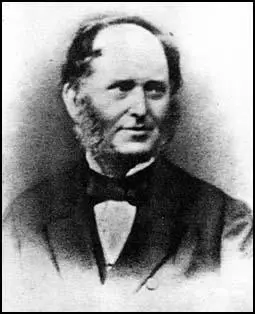|
Richard
Beard and the Daguerreotype Patent in England
1
Portrait
of Richard Beard (1801-1885)
Richard
Beard opened England's first photographic portrait studio
in London on 23rd March 1841 and made a fortune selling daguerreotype
licences.
|
Richard
Beard, a successful coal merchant, and patent speculator,
had seen the advantages of securing a monopoly in the production
of daguerreotype portraits in England. In June 1840, Beard
filed a patent which included the features of Alexander S
Wolcott’s mirror camera which, by drastically reducing
exposure times, would make the production of photographic
portraits more effective. Beard then employed the services
of John Frederick Goddard, a chemist and lecturer in science
who had been experimenting with various chemicals to sensitize
the silvered plates in an effort to accelerate camera exposure
times. Early in 1841, Goddard produced a mixture of iodine
and bromine to increase the sensitivity of the photographic
plates, thereby reducing exposure times to less than a minute
or, in bright sunlight, to a number of seconds. On 23rd March
1841, Richard Beard opened England’s first photographic
portrait studio to the public at the Royal Polytechnic Institution,
309 Regent Street, London. In June 1841, Beard concluded his
negotiations with Miles Berry, Louis Daguerre’s patent
agent in England, and purchased the patent rights to the daguerreotype
process. On 16th July 1841 Beard signed an agreement with
Daguerre and the son of Nicephore Niepce, the man who
had made the first successful photograph from nature in 1826.
|
By
the end of July 1841, Beard had become the sole patentee of the
daguerreotype process in “England, Wales and the town of Berwick
on Tweed, and in all Her Majesty’s Colonies and Plantations
abroad” and had a virtual monopoly in the production of photographic
portraits using Daguerre’s method.
Beard’s
only serious rival in the field of daguerreotype portraiture in
1841 was Antoine Claudet, a French glass
merchant living in London,who had made direct contact with Daguerre
in France and had secured from the inventor a licence to make daguerreotype
portraits in London.
Until
the patent rights of British Patent No 8194 expired on 14th August
1853, any person who wanted to legally carry out the art of daguerreotype
portrait photography on a commercial basis had to apply to Richard
Beard, to either purchase the right of patent in a prescribed geographical
area or to purchase a licence to work the process in a particular
town or city.
CLICK HERE TO CONTINUE
England's First Provincial Photographic
Studios
Website
last updated: 23 December, 2002
This
website is dedicated to the memory of Arthur T. Gill (1915-1987), Sussex
Photohistorian
|